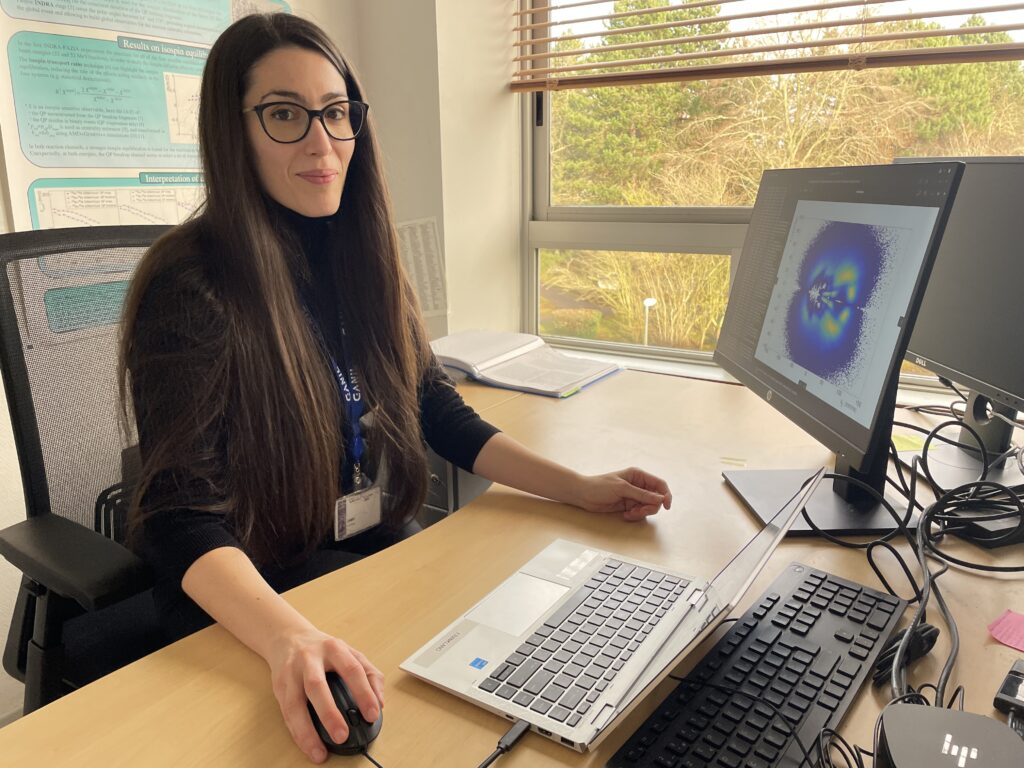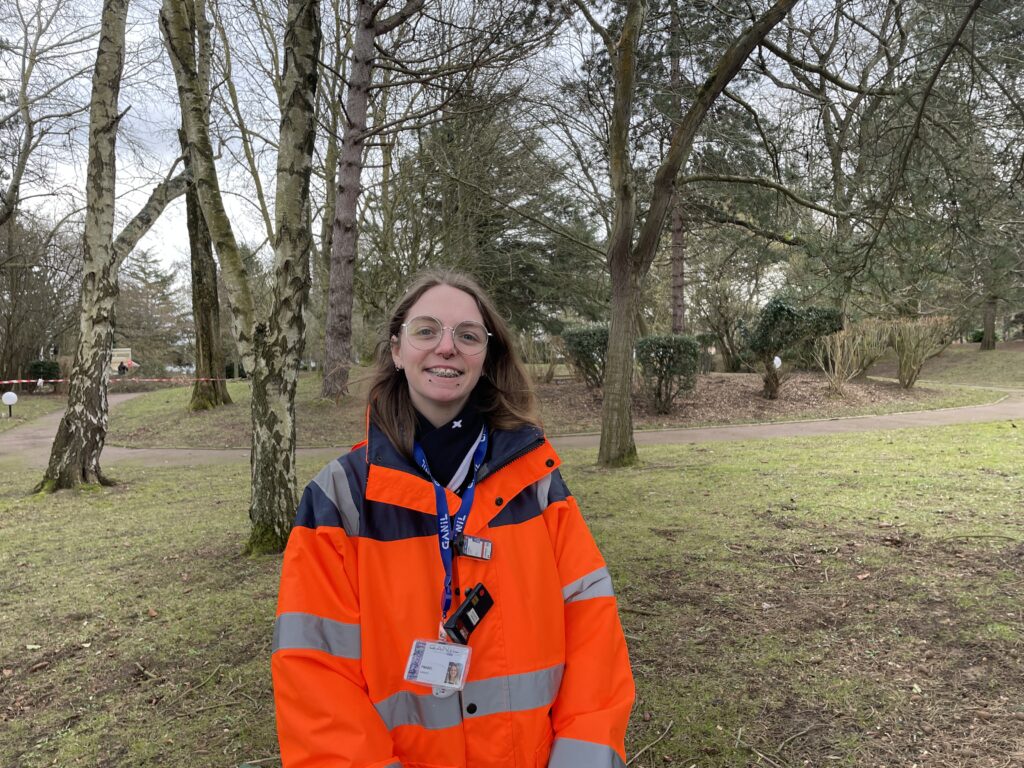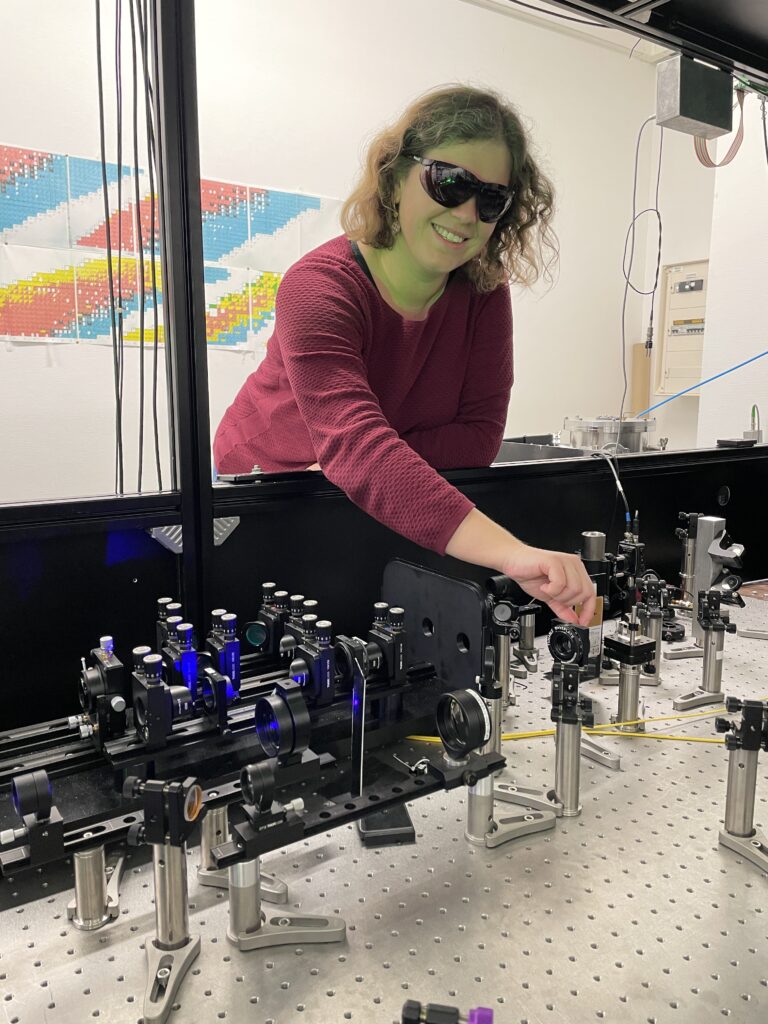- Homepage
- >
- Scientists
- >
- News & Highlights
- >
- 2025
- >
- International Day of Women and Girls in Science
International Day of Women and Girls in Science
Caterina Ciampi, nuclear physics researcher

I work in the field of nuclear dynamics and thermodynamics within the INDRA-FAZIA collaboration. My activities at GANIL are experimental and range from preparing and directly participating in experiments to analyzing and interpreting the collected data. I have mainly focused on how the composition of nuclei, in terms of protons and neutrons, evolves during nuclear collisions, a phenomenon known as isospin transport.
Experimentally, we analyze the nuclei produced in reactions by identifying them, studying their energies and emission patterns, and aiming to reconstruct the processes that created them.
Studying these processes provides insights into the nuclear equation of state, which is not only relevant to nuclear physics but also plays a key role in describing astrophysical objects such as neutron stars and in modeling core-collapse supernovae.
What first drew me to this field was the opportunity to dedicate my time to answering the questions that naturally arise when observing the world around us. Physics provides the concepts, tools, and methods to approach these questions, allowing us to explore the underlying structures and patterns within the phenomena we encounter.
Contrary to common belief, being a researcher is a very creative job. We are often faced with complex problems that need to be identified and addressed, without predefined solutions or standard procedures to follow. I have always found this aspect very stimulating because we never get stuck in the same mental frameworks.
I also love the collaborative spirit in which most of this work takes place. We almost never work alone, and interaction with others is key to achieving interesting results. Furthermore, many collaborations take place in an international environment, which offers an extraordinary opportunity: the chance to interact with cultures very different from our own, working together toward the same goal. Today, building these bridges is more important than ever.
There is no need to remind girls that they have all the abilities required to succeed in STEM fields, it is absolutely obvious. Young women themselves are increasingly aware that they have the right tools to pursue scientific studies, as shown by the growing proportion of female physics students at universities worldwide. The real challenge, however, comes after their studies, when female participation drops drastically. This decline is probably driven by multiple factors, including social pressures that, unfortunately, become stronger at this stage of life and often dictate what is considered “appropriate” for women, shaping the priorities they should set and the behavior they should adopt. Regarding the latter, for instance, women are more easily perceived as aggressive when they are simply determined. In a competitive field like research, this can be an obstacle. I believe it is very important to be aware of these “traps” so as not to be influenced by them and to follow our aspirations without compromise.
Sunniva Pinabel, apprentice engineer in industrial engineering

I am in my 2nd year of industrial engineering school at GANIL. I have been an apprentice in the laboratory for two years as deputy head of a project called TARDIS. The aim of this project is to set up radioactive targets for experiments on the discovery of so-called ‘superheavy’ atoms that have not yet appeared on the periodic table of elements!
I am in charge of the project management and safety coordination. After all, handling highly radioactive targets is no simple matter! My job involves regulatory monitoring, i.e. checking that the project complies with regulations, organising the implementation of a technical solution that brings physicists and safety staff into agreement, and so on.
What I like about my work is the diversity of jobs: operators, technicians, engineers, researchers, whether in mechanics, handling, vacuum or cryogenics… There are so many different areas to discover, all of which are more or less far removed from theoretical physics! And all of them together make it possible to operate a particle accelerator. Each one adds its stone to the edifice in its own way.
I discovered GANIL following a school visit with the high school, I was fascinated by the complexity of the machines. But above all, I was fascinated by the fact that anyone can come and work there. And that’s what I’d like to emphasise: that you shouldn’t be afraid of taking up a scientific career, because anyone can work in research!
Sarina Geldhof, instrumentation research engineer

I am a research engineer specialised in laser experiments, after having obtained a PhD in experimental nuclear physics. A lot of my time is spent in the laser laboratories of GANIL, testing and setting up the lasers for experiments. I also work on other related equipments, such as ion traps and detectors for radioactive decay. Combining all those techniques allows us to perform experiments to measure fundamental properties of atomic nuclei, such as their shape, size and mass. After the experiments, I help with the data analysis and preparing the results to be published. All of this is of course done within a team of other technical people, researchers, PhD students, postdocs, and as part of an international collaboration. This means I am often also training and supervising students and new people in the laser labs. A few times per year, I attend workshops or conferences to present my teams’ work, and to discuss with other researchers working on similar topics in other labs.
I love how hands-on my work is, the time spent in the lab. There is so much variety as well, as we are constantly looking for ways to improve our experiments. I get to teach a new generation of students, while also still continuously learning new things myself from other experts in GANIL or other European labs. Before arriving at GANIL, I had the opportunity to work in several other European labs, which has helped to establish an international network/collaboration, and I have always liked how many new interesting people I get to meet through work.
Starting in science or research could perhaps feel daunting, especially at the start when you encounter complex concepts and technical challenges. However, once you get going, the thrill of discovering something new, to find an answer to a, so far, unanswered question, is unmatched. The research environment is also very stimulating as it is constantly evolving. Additionally, the atmosphere in the labs and the research centres is collaborative, favouring mutual support and creativity.
